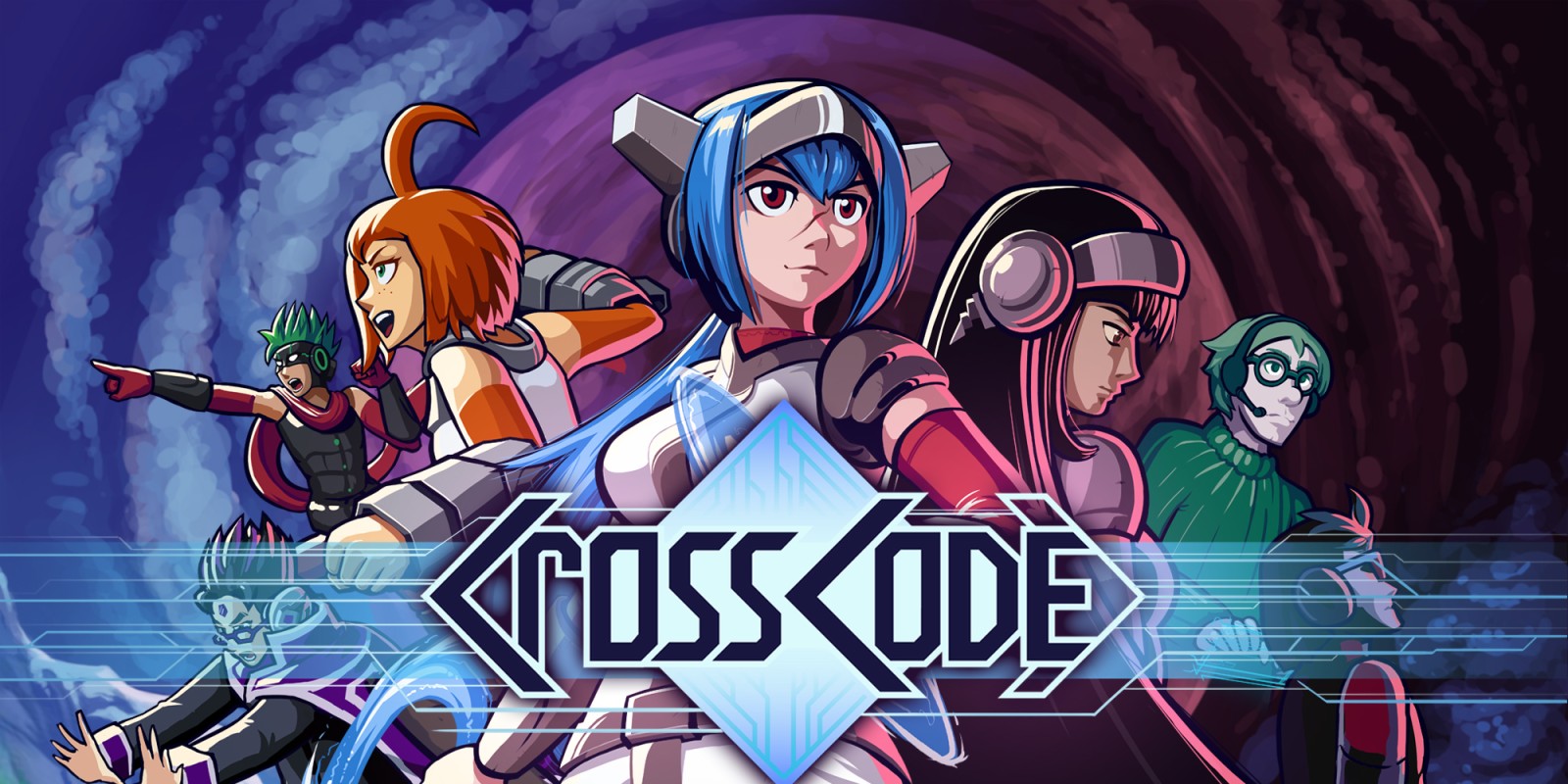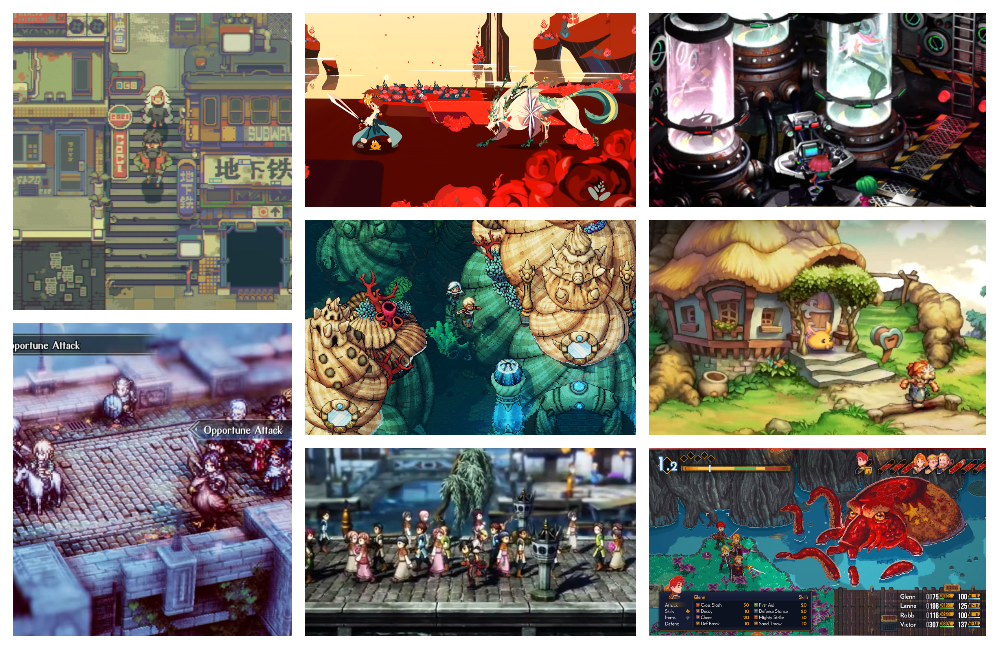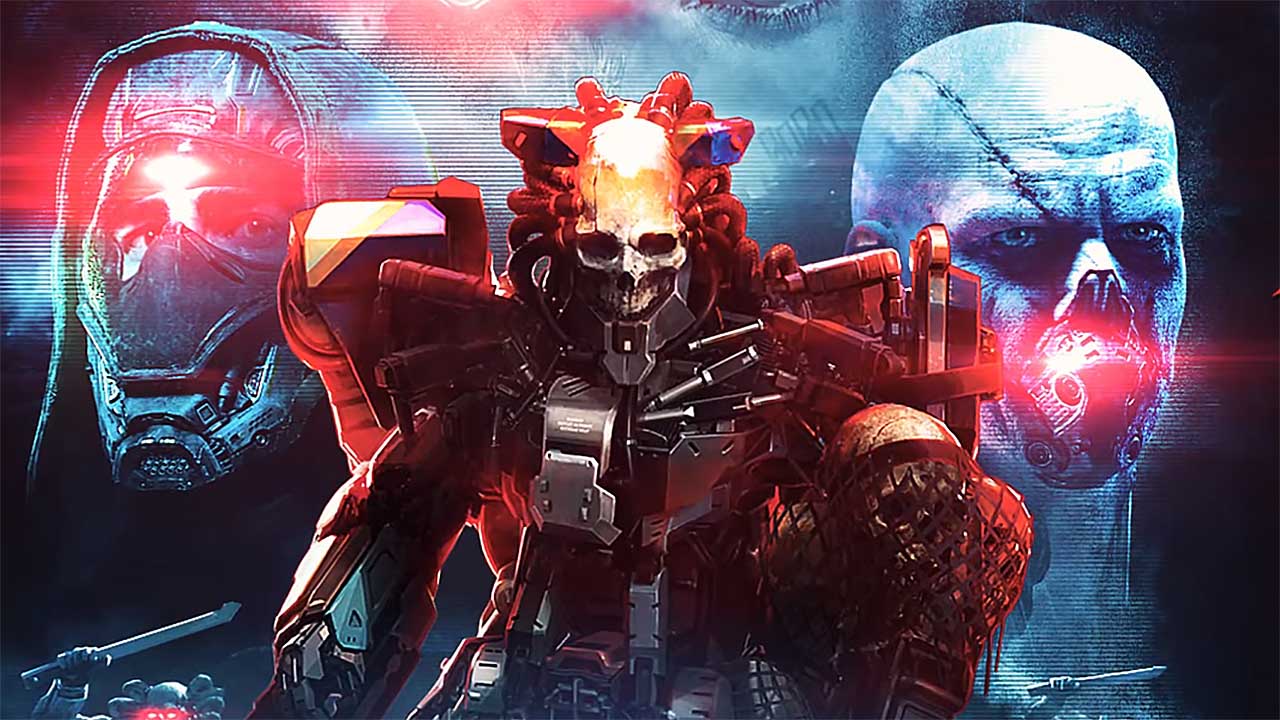Chained Echoes Review (PS4) – What Once Was Old Is New Again
Kickstarted in 2019 and developed over the past seven years, Chained Echoes is the passion product of developer Matthias Linda. A love letter to SNES and PSX JRPGs, but does Chained Echoes stack up against its inspirations?
A Solid but Familiar Plot
Chained Echoes follows the story of Glenn, a mercenary, who finds himself at the centre of a conflict on the continent of Valandis. War has raged amongst its three kingdoms for six generations.
In Chained Echoes’ opening act, Glenn groups up with several other characters, each with their reasons for joining him in his quest for peace for the continent. By the end of the game, the party had grown to 12 (4 of which joined via optional side quests), we had 4 sets of Sky Armor (mechs), an airship, and we’d started an adventuring clan on an island base filled with recruitable NPCs.
Chained Echoes does a great job pushing you through its story by ending each of its 4 acts with moments that legitimately made my jaw drop. It wears its influences on its sleeve, but by mixing and matching otherwise familiar plot points, it ends up feeling like its own thing. The pacing is excellent throughout, and there’s barely any filler or fluff to drag the experience down.
That’s not to say I don’t have any issues with Chained Echoes, however. While I liked the cast, with a ton of variety that each character brings into battle, I didn’t particularly love any specific character. Each non-optional party member has an arc and grows throughout the story, but the optional party members don’t get the same treatment. I understand why: they’re optional, so they can’t have too big of an impact on the story in a game of this scope. They get their side quest and a few bits of dialogue here and there, but otherwise, they’re just along for the ride. A great party does a lot for me in JRPGs, and while the one in Chained Echoes is good, it just isn’t up there with some of my fondest parties in the genre.
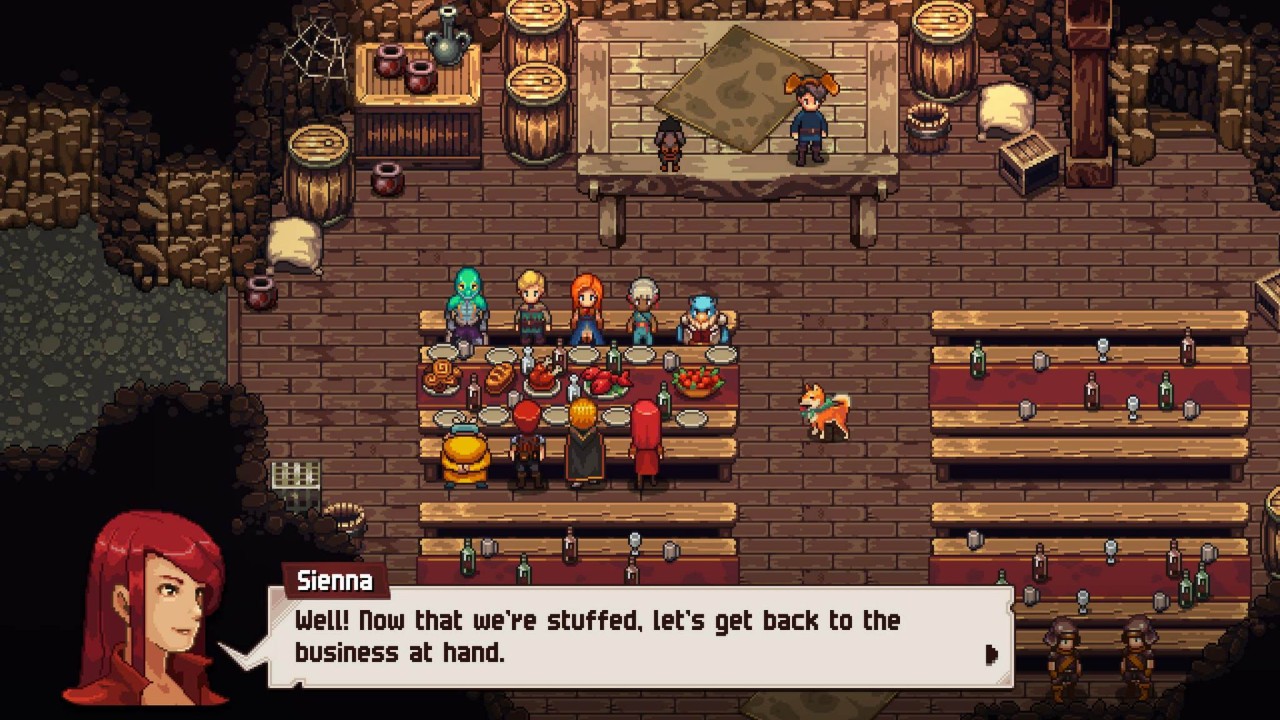
I also would’ve loved a glossary for all the characters, locations, and terminology I encountered. Chained Echoes’ story has lots of moving parts, and I had difficulty recalling some of the characters I’d met. It’s odd that this doesn’t exist because there’s an in-depth bestiary and a journal keeping information about each step of your quest.
I also thought that Chained Echoes rushed its final act a little. There were loose ends that never wrapped up, and several characters seemed to just be written out of the story as if the developer just didn’t know what to do with them. I was still ultimately satisfied with it, however, even if some smaller elements didn’t quite do it for me by the story’s end.
The Combat System
While Chained Echoes’ story may be familiar, it’s in its gameplay where the game does a lot to set itself apart. Matthias Linda has filled his game with some genuinely excellent bits of design that I’ve never seen done before. Chained Echoes’ combat system may be my favourite in any turn-based JRPG I’ve ever played. It’s up there with Shin Megami Tensei’s Press Turn System or Final Fantasy X’s system that lets you swap party members without losing a turn.
Battles are turn-based, and there are no random encounters, letting you avoid fights in certain areas if you want to. This has become more commonplace in modern JRPGs, but it’s still a much-appreciated feature, as I tend to find random encounters can spoil a game’s flow. Another bit of design I appreciated is that the party’s HP and TP (MP equivalent) is refilled after every battle. This allowed me to focus on single fights instead of carrying a ton of items I’d otherwise hoard should I need them later. You can also retry from the start of a battle, load the most recent autosave, or manually select a save should you die. If you opt to retry the battle, the game will let you tweak your equipment and party set-up, which is a nice accessibility touch.

Chained Echoes also doesn’t have a traditional XP/levelling system. Instead of levelling up with XP to get stronger and unlock new moves on a linear path, you’re given a page of skills for each character and skill points for beating bosses or completing special tasks.
Play Your Way
Each character has 48 skills to unlock. Each skill page is separated into 4 sections of 12: get enough skills in one, and the next section unlocks. There are 3 skill types: Action Skills that give you new commands to use in battle, Passive Skills that give you various stat boosts, and Stat Boosts that permanently increase the associated stat. Each skill has 3 levels of power, raised by beating monsters and gaining SP. Each fight awards between 1-20 SP depending on the difficulty. This SP is then applied to every skill every character unlocks. Once a skill gains enough SP, it will level up. A levelled-up skill will either cost less TP, deal more damage or buff a stat by a higher percentage. Each character is also given the same amount of SP to apply to the skills of their choice. Each character can have a stock of up to 999 SP, and it’s great for quickly levelling up newly acquired skills that might feel a little underpowered otherwise.
This skill system gives you a great deal of freedom with how each party member plays. While they all have a traditional class type, letting the player decide which moves they’ll use lets each character play differently for each player. Each party member can have 8 active action skills and 5 active passives, so while there’s a lot to unlock on the skill tree, it’s never overwhelming to manage these skills in a fight.
There are even 12 optional sub-class items to find throughout Valandis to further specialise each party member. They can be equipped to any character, giving them an additional 2 Action Skills and 2 Passive Skills. It’s an amount of freedom rarely seen in the genre.
The only downside to this is that there’s no way to respec your characters. In the late game, this isn’t too much of an issue as I’d accumulated a ton of skills, but earlier to mid-game, it’s possible that someone might unlock skills that they end up not using or enjoying.
Kick it into Overdrive
Your party can have eight members at any one time. These eight members split into pairs; four are active in battle, with the others waiting in reserve. You can switch between each pair of characters as the fight dictates, letting you set up debuffs or heal your injured party members before swapping back to bring out heavy hitters. There are limits to this, however. Each pair can only swap once per turn, and if they’re KO’d, then you can’t swap at all.
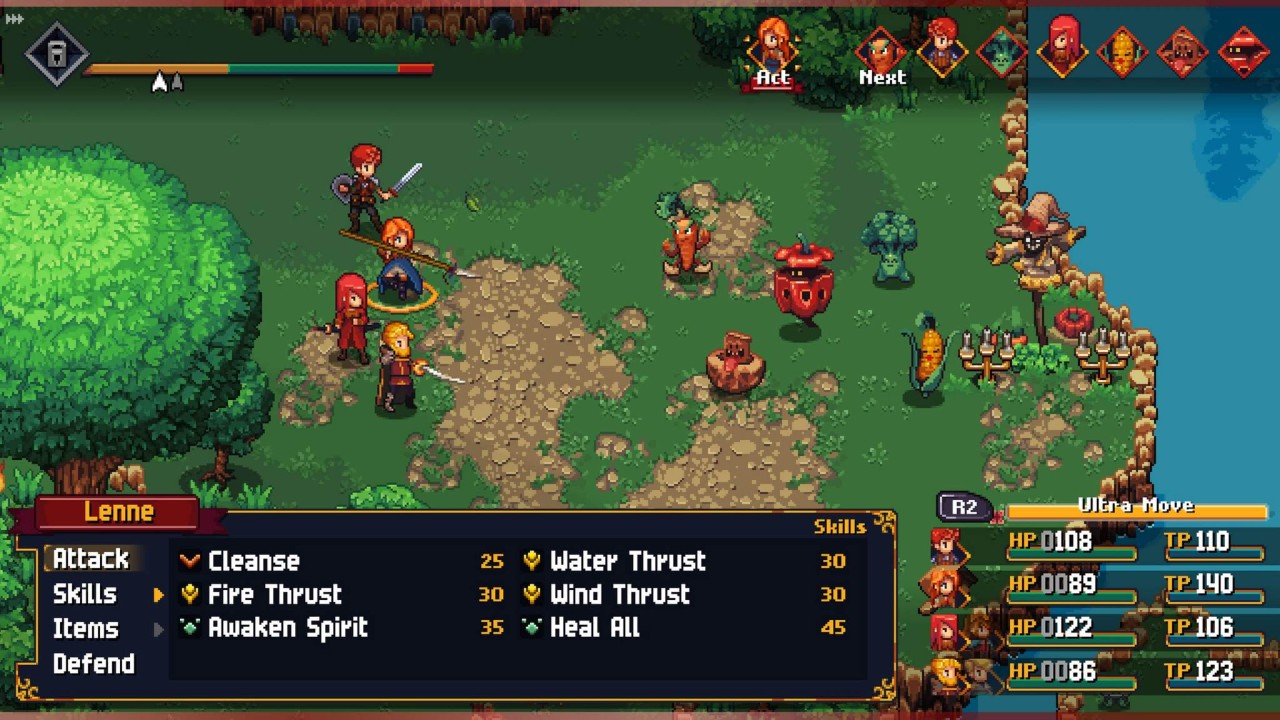
This system on its own is neat but isn’t totally unheard of. Where it really becomes something special, however, is with Chained Echoes’ Overdrive system. In the top left corner is a bar with 3 coloured sections: yellow, green and red. At the start of a fight, the arrow on the bar will be in the yellow section. In the yellow, your characters receive no benefits or downsides. As you hover over different actions on the command menu, a second arrow will show where that action will put you on the Overdrive bar. You always want the bar to be in the green. In the green section, your party deals more damage, takes less, and all skills cost half their TP.
However, taking damage also advances the Overdrive bar. Advance too far, and you’ll end up in the red section, and your party will take significantly more damage. You have 4 ways to make the overdrive gauge recede and keep it in the sweet spot. Defending, switching out a character, using an Ultra Move (think limit break, but it’s a party-wide meter instead of per character), or using a skill type (Physical/Magic/Buff/Debuff etc.) matching the one displayed on the Overdrive bar.
I absolutely love the overdrive bar. This little tug-of-war microgame inside of combat kept me engaged in every fight, be it common enemies or endgame optional bosses. It lets every party member feel useful and helps you plan in advance by ensuring each character has some skill variety to lower the overdrive bar and keep you in the green.
The Other Combat System
There is also Sky Armors, pilotable mech suits with unique mechanics. You unlock access to Sky Armor and an airship early into act 2 (it took me between 10-12 hours), and they open up the world considerably. In most areas (with some exceptions), you can call down your Sky Armor and use them to hover and fly around the map. This grants you access to previously unreachable areas. It also lets you fight monsters that you couldn’t handle on foot.
Sky Armors have their own weapon types, with their skills being tied to the weapons each Armor has equipped. As you fight, you become more proficient with your weapons and unlock more skills with that weapon type. Any passive skills unlocked for these weapons are permanent, but the Action Skills are locked to that type of weapon.

Combat in Sky Armor is basically its own system. Instead of the Overdrive bar, you have an Overheat bar. It’s a yellow bar with a smaller red section on each end. You start each fight in Sky Armor in the middle of the bar, but like with the Overdrive bar, any actions or damage will advance the bar towards the red. Where it is different is in the Sky Armours 3 Gear System. Pressing R1 changes your gear from 1 to 2 to 0 and then back to 1, but you can only switch gears once per turn. Gear 1 advances the bar to the right, gear 2 to the left, and gear 0 keeps it in place. But there’s a catch: each makes your Sky Armor act differently. In Gear 0, you can only use your basic attack, defend or use an item. In gear 1, your Armor acts normally. In gear 2, skills cost more, and you deal more damage, but you also take much more damage to counter it. It’s similar to the Overdrive system but is different enough that fighting in Sky Armor feels very different.
Lots to do to Save the World
Chained Echoes is a very systems-heavy JRPG. Hell, it’s one of its selling points on its website, and I’ve just spent a lot of time talking about its 2(!) combat systems. But there’s more to the game than the combat. As previously mentioned, the party forms a clan in the second act to gather allies for their cause. Because you also gain an airship, you can freely explore much more of Valandis. As you do so, you’ll come across various NPCs that will join the clan, come to your island and offer your party various services and bonuses that, while optional, are absolutely worth seeking out. Some will aid you in battle with buffs, and others give you access to shops and other features at your base. A couple of them are just for fun, like a dog that will play a random sound effect each time you interact with them. My favourite was the NPC that lets you see if there are any unopened chests, buried treasures or hidden caves in an area. It’s a nice little side activity to seek these NPCs out, and if you have trouble finding any of them, the very first one you get (that is unmissable) is a fortune teller who will give you clues on where to find would-be clan members, for a fee of course.
Then there’s the Reward Board. It’s made of sections for each of the main areas in Valandis. Each has several squares associated with a specific task for that area. Complete them, and you can redeem the reward for that square. These tasks range from exploring or finding chests to beating an enemy with a specific party line-up or beating one of the game’s many optional bosses.
As you complete tasks on the reward board, any completed tasks will form a chain with other adjacent completed tasks. There is another set of rewards for building up the longest chain you can, with the highest being for a chain of 120. It’s another little mechanic that helps with keeping track of the game’s massive amount of side content.
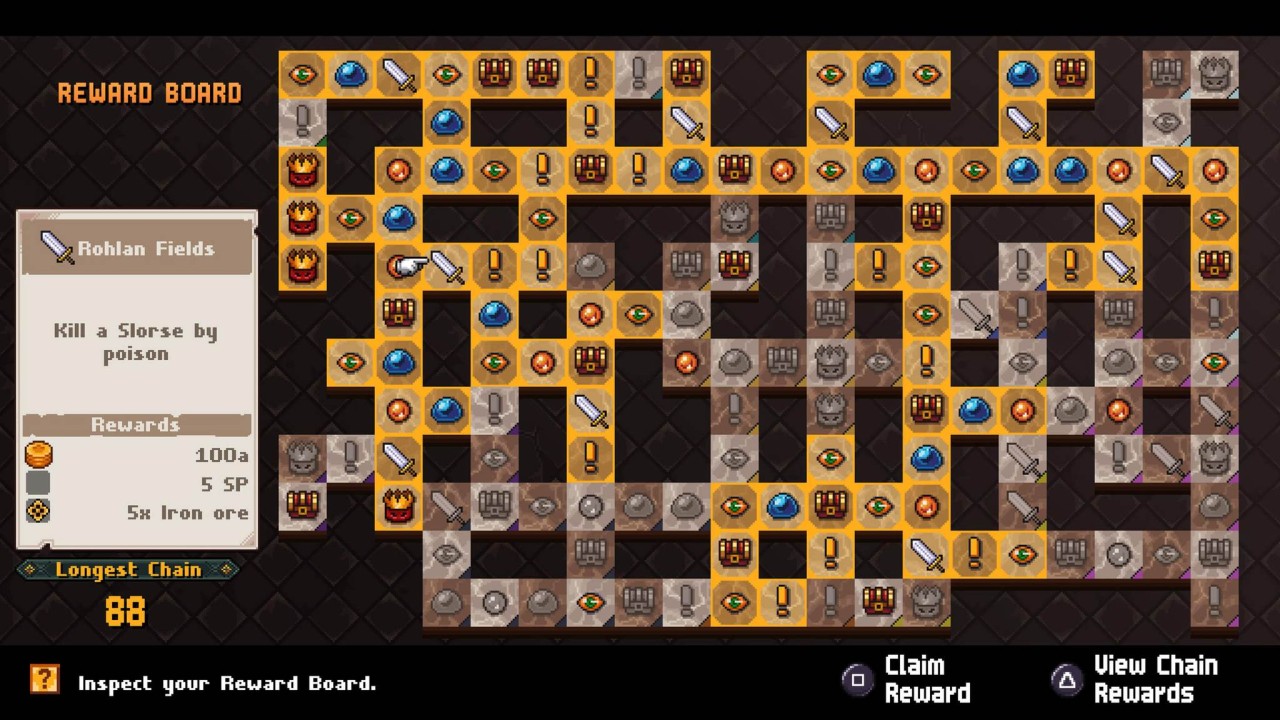
Alongside all this, you also have a crafting element. Weapons and armour can be upgraded with various materials. There are also crystals to find and combine that act similarly to FFVII’s materia system, but instead of giving you skills, they give you passive buffs. I upgraded my weapons whenever I could, but I didn’t engage much with the crystal system. I didn’t find it necessary to beat the main game content. A couple of the secret bosses towards the endgame kicked my ass, however, so getting a little more granular with using crystals would’ve helped in those much tougher encounters.
Looks and Sounds like you Remember
The art in Chained Echoes is gorgeous. It’s all rendered in very detailed pixel art, and the world is filled with great designs. There’s a range of fantasy races that all look very distinct, and monsters and boss designs range from cute to genuinely horrific. The whole game elicited vibes of something both old and new. It gave me that nostalgic feeling a good homage gives.
The soundtrack is equally fitting and absolutely fantastic. Because the game lacks voice acting (understandable, as it’s made primarily by one developer), the music has to do a lot of the work in some of the heavier scenes, and it does the job excellently.
Chained Echoes is an incredibly passionate love letter to 16-32 bit era JRPGs, but it also knows when to try new things and add modern conveniences. Its battle system is one of the best in the genre, and feels genuinely revolutionary. I was slightly underwhelmed by the game’s rushed final act and a couple of party members but Chained Echoes is a great game and is absolutely worth your time if you’re a fan of the genre.

Chained Echoes is available now on PlayStation 4 (review platform), Xbox One, Nintendo Switch, and PC.
Developer: Matthias Linda
Publisher: Deck13
Disclaimer: In order to complete this review, we were provided with a promotional code from the publisher. For our full review policy, please go here.
If you enjoyed this article or any more of our content, please consider our Patreon.
Make sure to follow Finger Guns on our social channels. Twitter, Facebook, Twitch, Spotify or Apple Podcasts – to keep up to date on our news, reviews and features.

